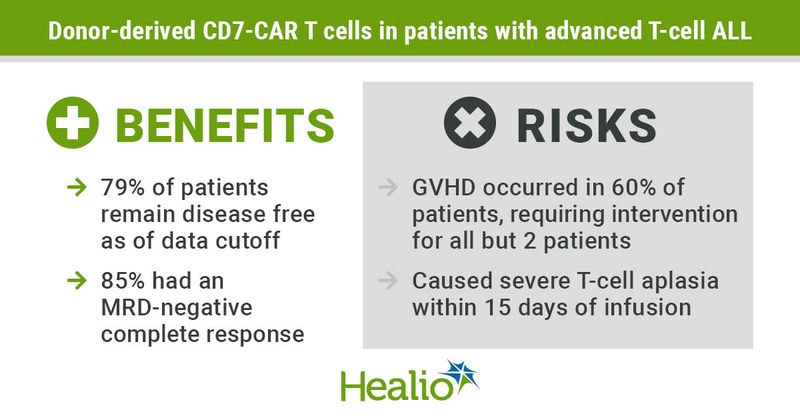Donor-derived CAR T cells show encouraging efficacy for advanced T-cell ALL
Ninety-five percent of patients with relapsed or refractory T-cell acute lymphoblastic leukemia responded to therapy with donor-derived chimeric antigen receptor T cells, according to results of a phase 1 study.
The data — presented during the virtual ASCO Annual Meeting — also showed 85% of patients achieved minimal residual disease (MRD)-negative status after a single infusion of the investigational therapy, which demonstrated manageable toxicity.

“Patients with relapsed or refractory T-cell ALL have limited treatment options,” Jing Pan, MD, director of the department of hematology at Beijing Boren Hospital in China, said during a presentation. “CAR T-cell therapy is a milestone for patients with B-cell malignancies, but there are obstacles that limit the use of CAR T-cell therapy for patients with T-cell ALL.”
Those obstacles include CAR T-cell fratricide — or mutual killing — that can occur during the manufacturing process when using a T-cell lineage antigen, such as CD7 or CD5, as the CAR target, Pan said.
Other impediments include difficulty harvesting enough healthy T cells from heavily pretreated patients and the rapid onset of T-cell immunodeficiency — known as T-cell aplasia — related to treatment that occurs after infusion.
Pan and colleagues used a novel allogeneic, gene-edited, CD7-directed CAR T-cell therapy derived from matched donors. The therapy was created with IntraBlock proprietary technology that uses an intracellular organelle-anchoring domain that retains CD7 to endoplasmic reticulum with the aim of preventing T-cell fratricide during the manufacturing process.
The single-center, phase 1 trial included 20 patients (median age, 11 years; range, 2-43; 80% male) treated with CD7 CAR T cells between July 18 and Dec. 21, 2020. Patients received a median three (range, 2-4) lines of previous therapy, and 12 (60%) had a previous hematopoietic stem cell transplant.
CAR T cells were manufactured using new HLA-matched or haploidentical donor T cells or donor-derived T cells reserved from the patient’s previous HSCT. Sixteen patients received lymphodepletion chemotherapy followed by a single infusion at a target dose of 1 × 106 (± 30%) CD7 CAR T cells per kilogram of body weight, with the remaining four patients receiving a lower dose of 5 × 105 (± 30%) cells/kg.
Safety, including treatment-related adverse events, served as the study’s primary endpoint. Secondary endpoints included measurement of short-term efficacy.
Median follow-up was 6.3 months (range, 4-9.2).
Safety results showed no dose-limiting toxicities. All study participants had cytokine release syndrome, with 90% experiencing grade 1 or grade 2 CRS and one case each of grade 3 and grade 4 CRS.
Median time to CRS onset was 1 day (range, 0-9), with a median duration of 7 days (range, 1-30).
Three patients (15%) experienced immune effector cell-associated neurotoxicity syndrome (ICANS). All had grade 1 ICANS and high leukemia burden in their central nervous system at the time of CAR T-cell infusion, according to the researchers.
Twelve patients (60%) experienced graft-versus-host disease — mostly skin manifestations — within 45 days of infusion. No patient had grade 3 or higher GVHD, and 10 patients required intervention with either ruxolitinib (Jakafi, Incyte; n = 2) or ruxolitinib combined with methylprednisolone (n = 8).
Grade 3 or grade 4 cytopenia occurred in all patients after infusion with CD7 CAR T cells and in 80% of patients before trial enrollment.
One patient died of a pulmonary hemorrhage while experiencing fungal pneumonia 5.5 months after infusion. Four patients (20%) had asymptomatic virus reactivations after infusion.
“Adverse events, such as CRS, GVHD and T-cell immunodeficiency, can be severe but manageable,” Pan said.
Only one patient failed to respond to therapy within 30 days of infusion, for an overall response rate of 95%. Seventeen patients (85%) had an MRD-negative complete response to therapy by day 30. Two patients had a partial response, one of whom discontinued the trial to pursue other treatment.
Seven patients received subsequent HSCT. Six of them, as well as nine of the 11 other study participants who had an initial complete response to therapy, remained alive and disease free as of last follow-up.
Pan said the results thus far are encouraging, but he noted the small sample size and brief follow-up time and said further study will be necessary.
“This therapy can be applied to patients who had a prior [HSCT] or for patients who are eligible for HSCT and have an available donor,” he added. “Our study demonstrates that donor-derived CD7 CAR T-cell therapy is feasible and may benefit patients with relapsed or refractory T-cell ALL.”



